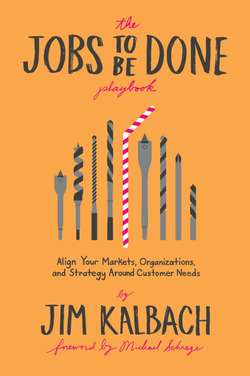Читать книгу The Jobs To Be Done Playbook - Jim Kalbach - Страница 11
На сайте Литреса книга снята с продажи.
How This Book Is Organized
ОглавлениеTo structure this book, I asked myself, what is the core job any business strives to get done? Peter Drucker reminds us of a good answer: “There is only one valid definition of business purpose: to create a customer... the business enterprise has two—and only these two—basic functions: marketing and innovation.”
In other words, businesses exist to create value—value as perceived by customers in satisfying needs (innovation) and value for the company by staying profitable (go-to-market).
From this perspective, I organized the techniques, or plays, in this book around the five stages in providing solutions that customers find valuable:
• Discover value: Find the right problem to solve for the people you serve.
• Define value: Set the direction for addressing the problem you’ve identified.
• Design value: Create solutions that are desirable, viable, and useful.
• Deliver value: Present the solution to the market in a successful business model.
• (Re)develop value: Continue to innovate and grow the business.
Figure I.1 illustrates how these stages come together in an iterative motion.
At the center is the core objective: develop an offering that people will value. To do that, organizations have to first discover and define what they believe customers value. This includes primary research and investigation, along with modeling customer behavior and finding the right opportunities. The left side of the diagram represents the innovation imperative that Drucker mentions.
FIGURE I.1 Providing solutions that customers value is an ongoing process between innovation and go-to-market activities.
The right side represents all the activities an organization does to create solutions and introduce them to a market. This begins with the design of the offering, which then must be delivered to the consumer. It includes everything from conception to planning and marketing to selling.
The cycle repeats: generating business and customer value is about constantly redeveloping your offering. That which is differentiated today will become table stakes tomorrow, and businesses have to constantly reinvent themselves. JTBD provides a consistent way to do that throughout an organization.
Note that this model is not intended to represent a process—rather, it reflects different modes of thinking and operation. A given business will be in all stages at the same time. It’s also important to keep in mind that I’m using this model to organize the various plays of JTBD, not as a practical framework of any kind.
After the book introduces JTBD, each of these stages is handled in a separate chapter. I select several plays to illustrate how JTBD can be applied within each mode of thinking. The last chapter brings plays together in methods or “recipes” you can use in different situations.
